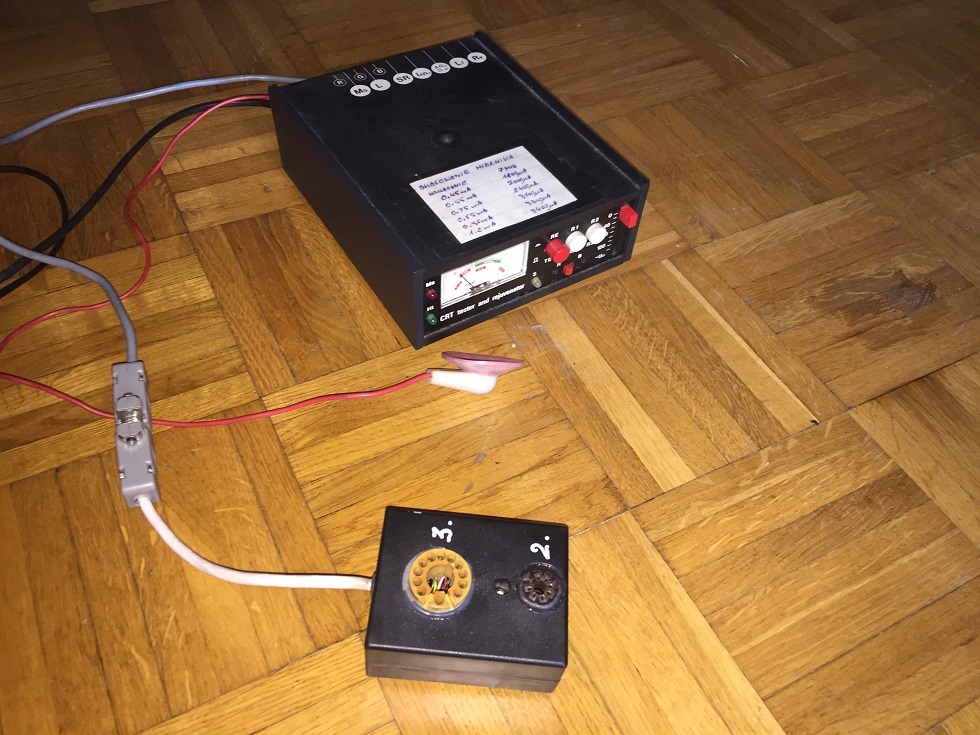The "real" regeneration, with the replacement of the tube tube, was carried out by the "Reskop" plant.
During the Polish People's Republic, "Reskop", as a branch of ZURT, was a plant for the regeneration of electronic components. The cathode ray tube regeneration department was located in Warsaw
at the Erazm Ciołek street. The CRT's had to arrive "not vented" for regeneration.
A CRT, in which air suddenly burst in, usually had a damaged screen due to a broken neck, "blown away" by a stream of penetrating air.
Such picture tubes were not accepted for rebuilding.
In the CRT regeneration plant, the neck of the electron gun was incised and a break was by touching the hot wire at the cut (scratch) site.
This picture tube was left undisturbed for a long time to slowly air out.
This could take hours or more. Then the old electron gun was removed. As the neck was slightly shortened during this operation, a new one was welded on.
Then a new one was put in, it was melted in and the picture tube was sent to the pumping station with oil diffusion pump.
After making a vacuum, the picture tube was annealed, the cathode was formed by passing a glow current on the pump. Finally, a getter (gas absorber) was sprayed and the picture tube was melted from the station. Later it was lit on another position (giving the necessary tension for the launcher and deflection).
Simple isn't it?
The existence of a CRT regeneration plant was justified by another fact. Well, in the Polish People's Republic there was a law that replacement components were to be available
for 10 years after the end of production of the device in which they are used.
Black and white cathode ray tubes from the so-called with a thick neck, with a screen similar to a rectangular one, with a neck diameter of 36 mm, was put into production in "Zelos" CRT factory around 1958.
These were, among others types: 35MK1, AW36-80, AW-43-80. Interestingly, we then bought a Philips license. Before that, we briefly produced the 31LK2B with round screen cathode-ray tube
to the TV set "Wisła". The last model to use a thick-neck tube was probably the "Alga" receiver with the AW36-801 tube. The production of "Alga" was discontinued
around 1970.
This would mean that the production of "thick-necked" CRTs should last until around 1980. The UNITRA-ZELOS monochrome CRT factory would have to
so have either two production lines (for new and old CRTs) or retool them. It was easier to collect used CRTs from the market and deliver them to "Reskop", while producing both types
of electron guns (new and old) only at the electron gun production department. In this way, the factory was relieved of the obligation to carry out all stages of the production
of obsolete types of picture tubes.
From today's perspective, it must be admitted that regeneration was also pro-ecological.
In the 1990s, "Reskop" probably did not provide cathode ray tube regeneration services anymore. Besides, I do not know if it has ever provided a color picture tube regeneration service.
If so, it was probably about the models of picture tubes used in Soviet color TV set called "Rubin" -, also manufactured under license in Poland.
In the 1990s and in the first decade of the 21st century, there were private regeneration workshops. I know about two. One was located in Zambrów, the other in Warsaw
at Płońska street. This workshop was run by Eng. Paprocki. As soon as the color CRT televisions "ran out", the demand for
regeneration services. Therefore, these workshops finished their activities.
Today a cathode ray tube TV is vintage .
It happens occasionally that a machine requires such an old monitor to work with it. These are, for example, CNC machines of an older date, still functioning here and there.
Then you have to think: persistently look for a picture tube or a second monitor. You can also try to use some converters, although the result is not always satisfactory.
A big worry is to repair some really very old vintage TVs. In the case of Polish models, I mean those produced in the 1950s and 1960s,
so "Wisła", "Belweder", the first "Neptunes" etc. Buying a new picture tube from old stocks for these TV sets is like looking for a unicorn.
The picture tubes, as occupying a lot of space, were not very readily kept. Hence, their availability is much lower than that of small electron tubes,
which was easy to toss into the corner of the wardrobe or on the storage space.
Thus, if the cathode ray tube was damaged, it would be repaired. How to do it, since "Reskop" or other plants of this type are long gone?
So it remained to try to perform the necessary operations yourself. I have made my first unsuccessful attempts over the last few years, although I thought
about it since 2007. I finished the first successful one in May 2020.
Kineskop, który posłużył do testów, był kineskopem, który został co najmniej kilka lat wcześniej przez kogoś zapowietrzony (ułamana rurka pompowa w cokole).
Był to mały, dość nowoczesny kineskop. Chodziło mi o to, aby w razie porażki nie było szkoda, że się nie udało.
Poniższy obrazek nie przedstawia dokładnie tego egzemplarza, ale uszkodzenie było właśnie takie.
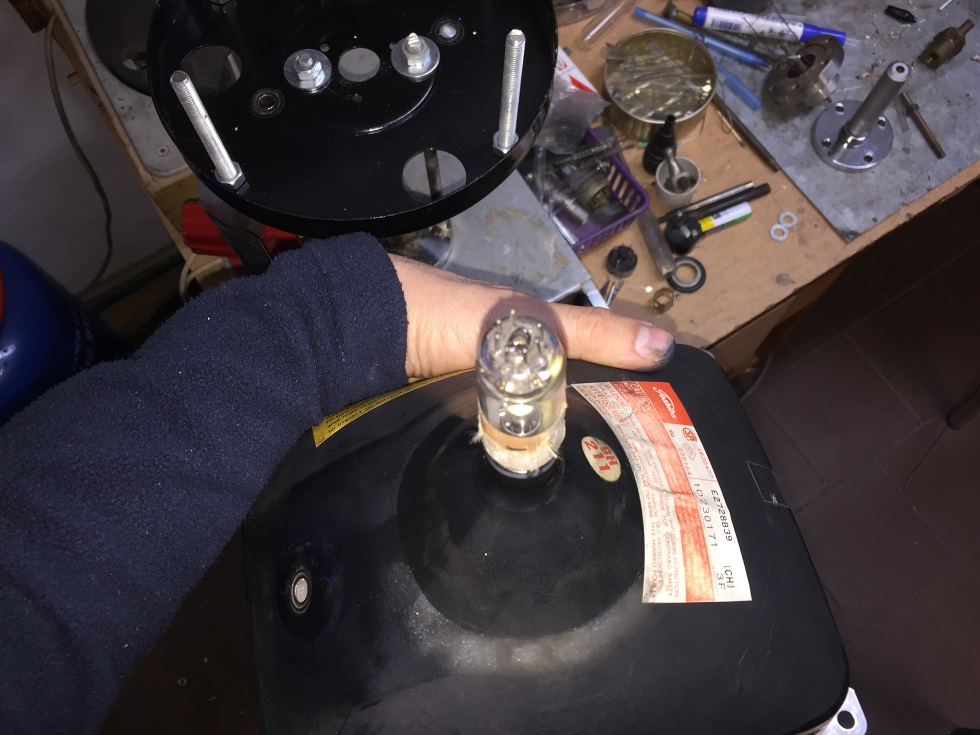 |
Spróbowałem obejrzeć ekran kineskopu w świetle lampy ultrafioletowej, ale nic ciekawego nie było widać. Ekran nie chciał świecić.
Prawdopodobnie luminofor nie jest siarczkowy. Postanowiłem jednak nie zdejmować ekranu i nakładać nowego
(takie operacje prowadziłem z powodzeniem już kilka lat wcześniej) i skupić się na wymianie wyrzutni. Starą wyrzutnię trzeba było odciąć.
Z tym poszło dość prosto. Potem należało przedłużyć szyjkę.
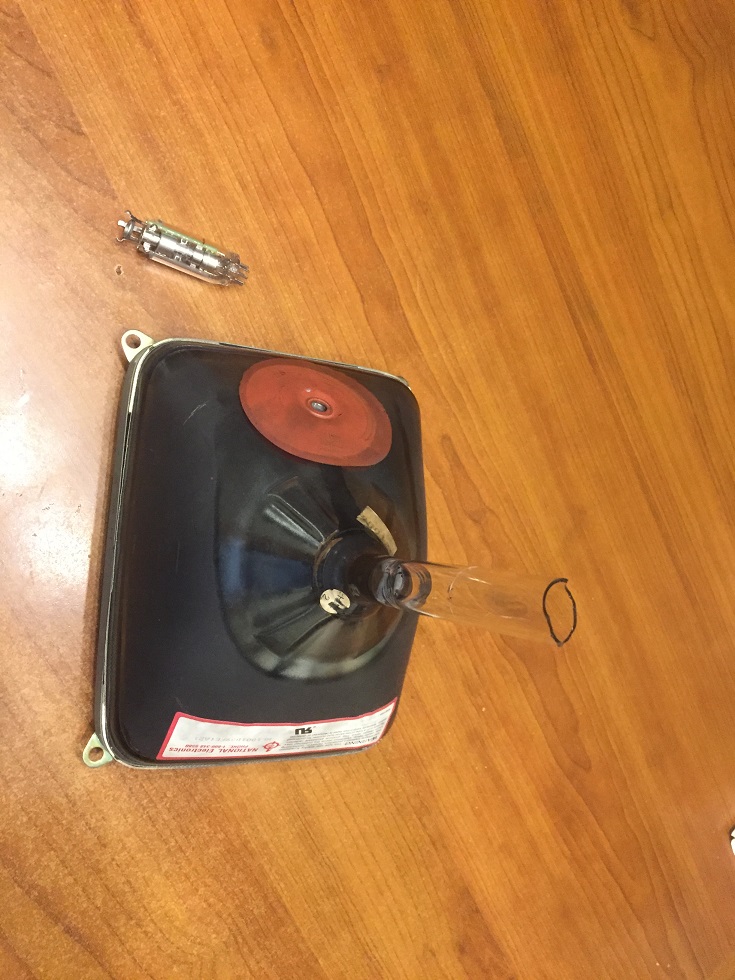 |
Operacja przytapiania szyjki była prowadzona w ten sposób, że kineskop trzymałem w ręku, a w drugiej rurkę. Nie było to zbyt wygodne i z większym kineskopem
nie mógłbym tak postąpić. Nie utrzymałbym go w ręku.
Po pomyślnym przytopieniu szyjki skróciłem ją na odpowiedni wymiar.
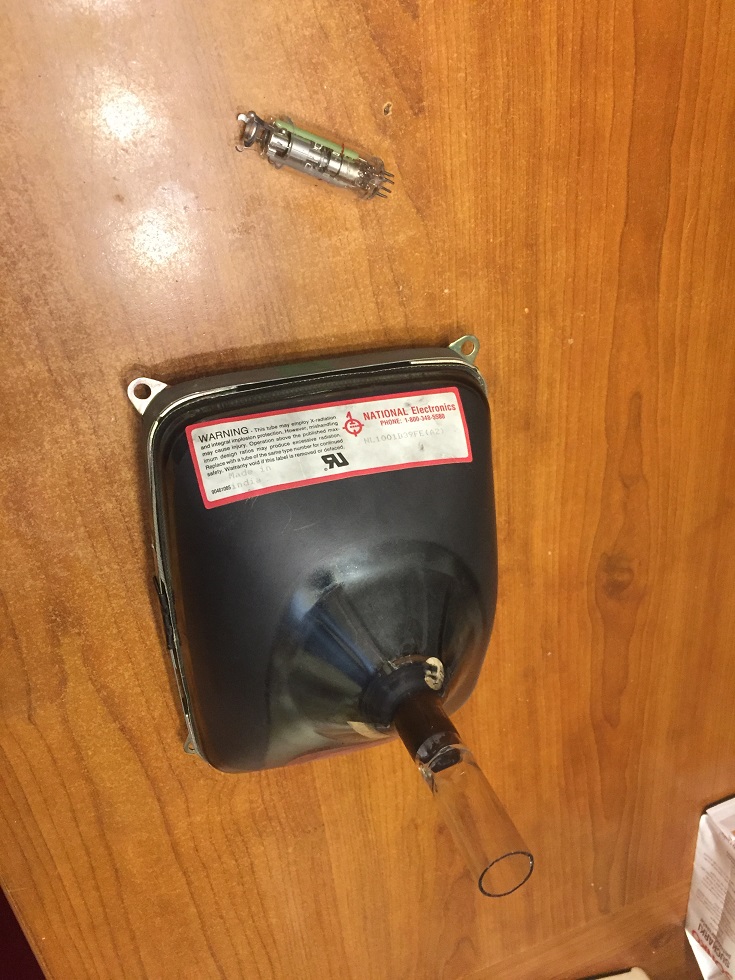 |
Teraz mogłem przymierzyć nową wyrzutnię, wziąwszy z magazynu właściwą (2. od góry)
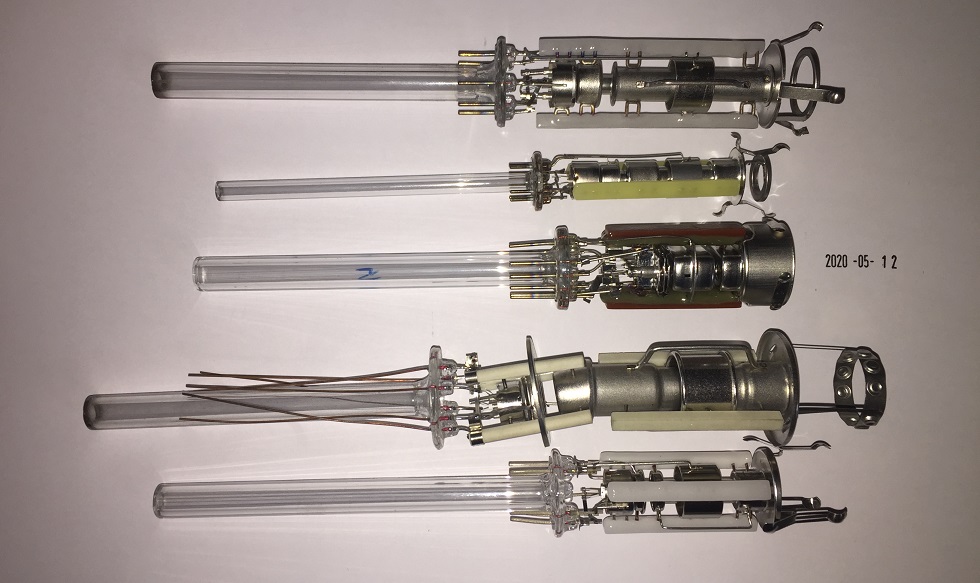 |
Następnie można było przymierzyć cewki odchylające (czy dadzą się założyć na nową szyjkę)
Po poprawkach udało się to. Można było więc przystąpić do zatapiania wyrzutni kineskopu:
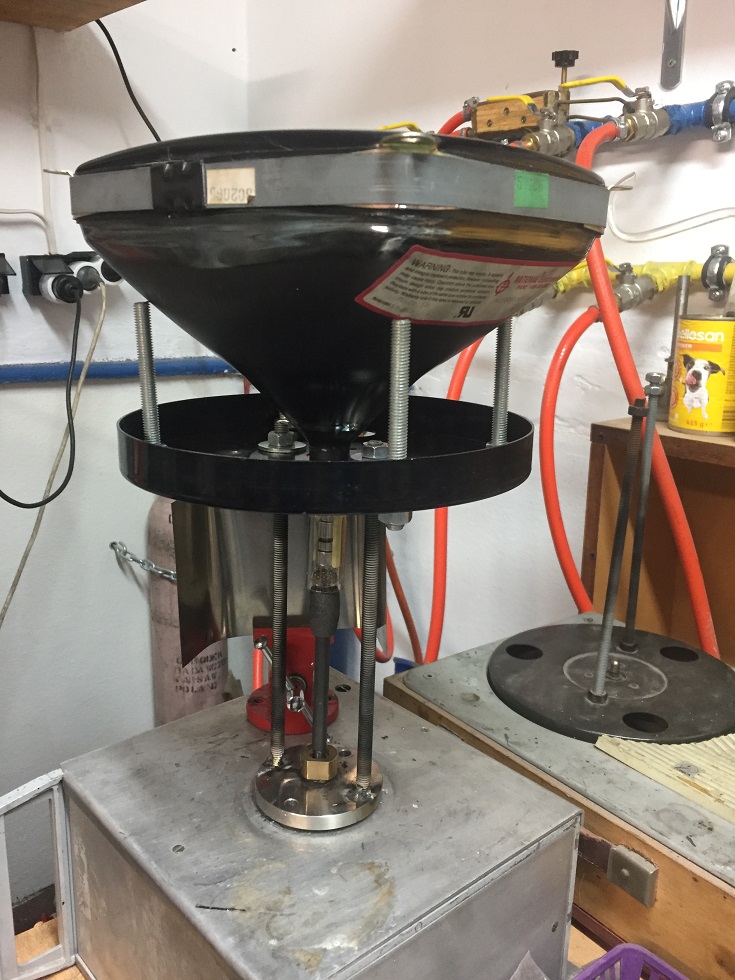 |
Co się zresztą tyczy zatapiarek służących do tego celu, to są dwie konstrukcje: Z wirującym kineskopem i nieruchomymi palnikami oraz z wirującymi palnikami,
a nieruchomym kineskopem. Prościej było mi zbudować ten pierwszy typ zatapiarki, natomiast niech za przykład drugiej konstrukcji posłuży konstrukcja z OBREP-u.
Pochodzi ona prawdopodobnie z 1976 r., z czasów intensywnej pracy nad telewizją kolorową w Polsce.
 |
Po operacji wtapiania wyrzutni pozostało odprężyć wtopioną wyrzutnię:
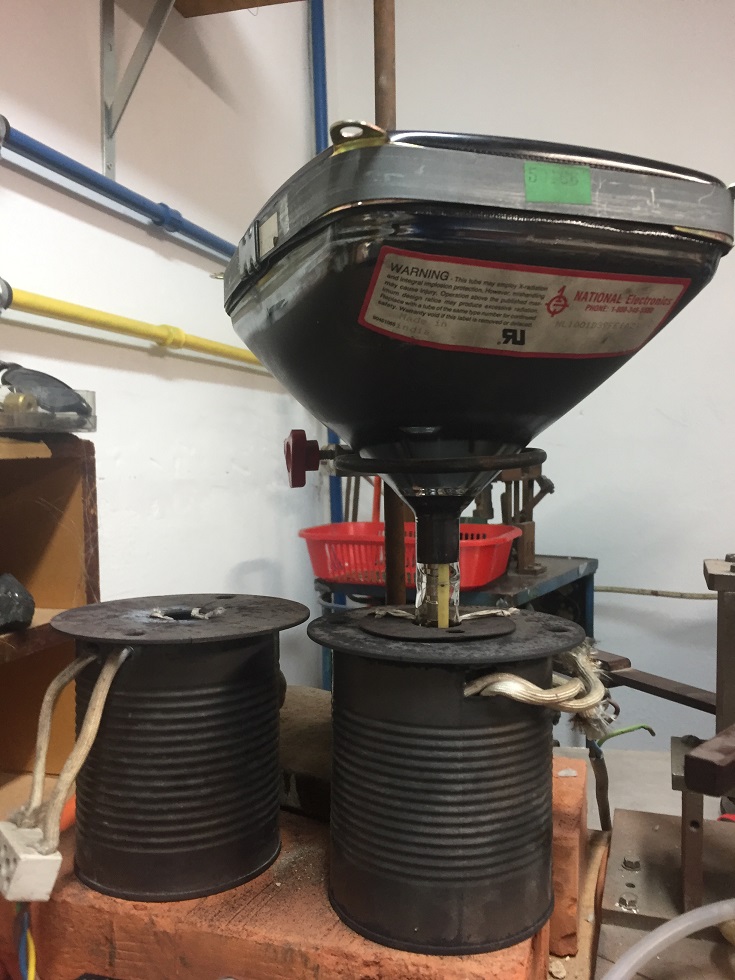 |
Otrzymałem więc kineskop gotowy do pompowania:
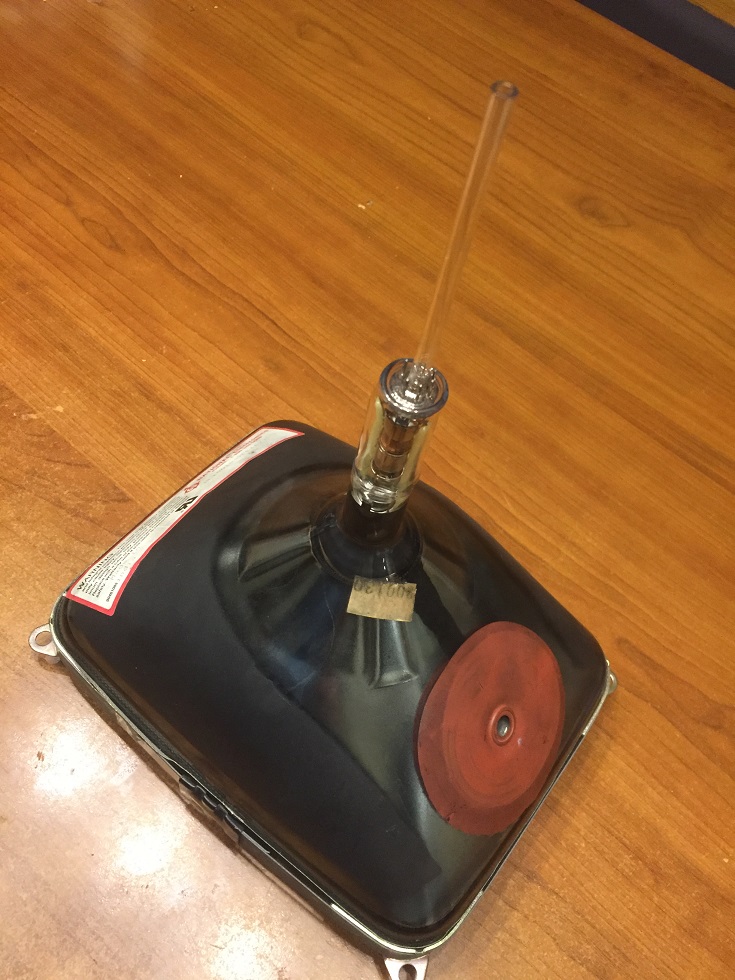 |
Normalnie takie kineskopy były pompowane i jednocześnie wygrzewane. Stanowiska pompowe miały specjalne szafy wyposażone w grzałki.
Ja tego nie miałem, więc postanowiłem wygrzać kineskop, na ile się to da przy użyciu hot aira, wydłużyć czas pompowania i po odcięciu od
stanowiska prowadzić je dalej przy użyciu małej pompy jonowo-sorpcyjnej.
 |
Takie technologiczne pompy jonowe są często stosowane do pompowania lamp mikrofalowych.
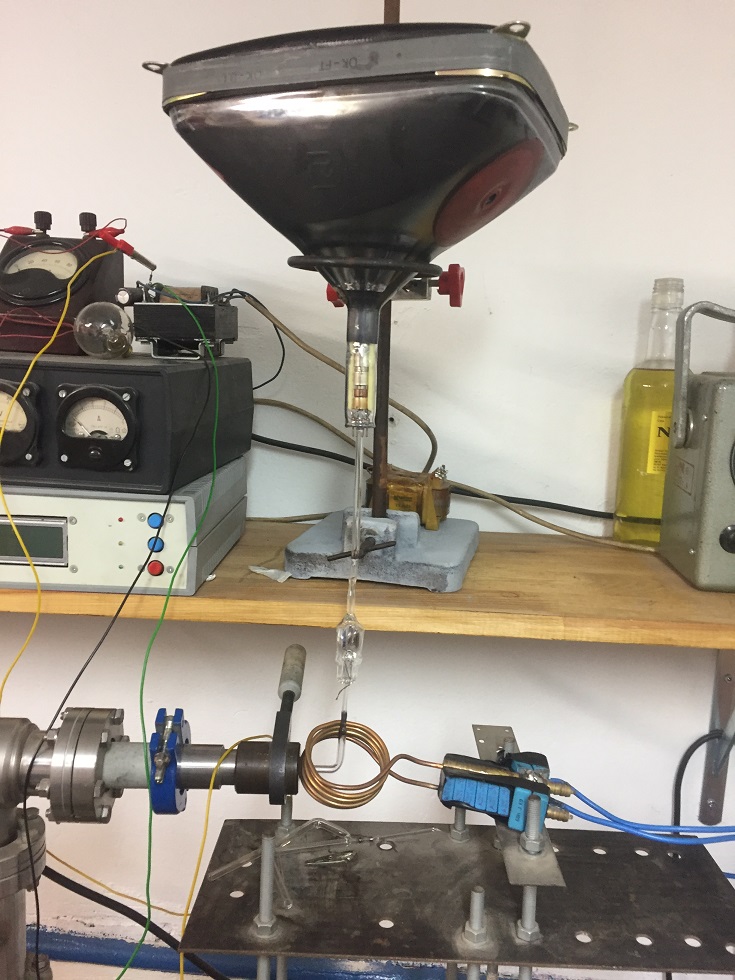 |
W trakcie pompowania miało miejsce wstępne formowanie katody.Podczas tego procesu doprowadza się napięcie żarzenia. Wskutek działania podwyższonej temperatury
na katodzie powstają tlenki, z któych bedzie zachodzić emisja elektronów.
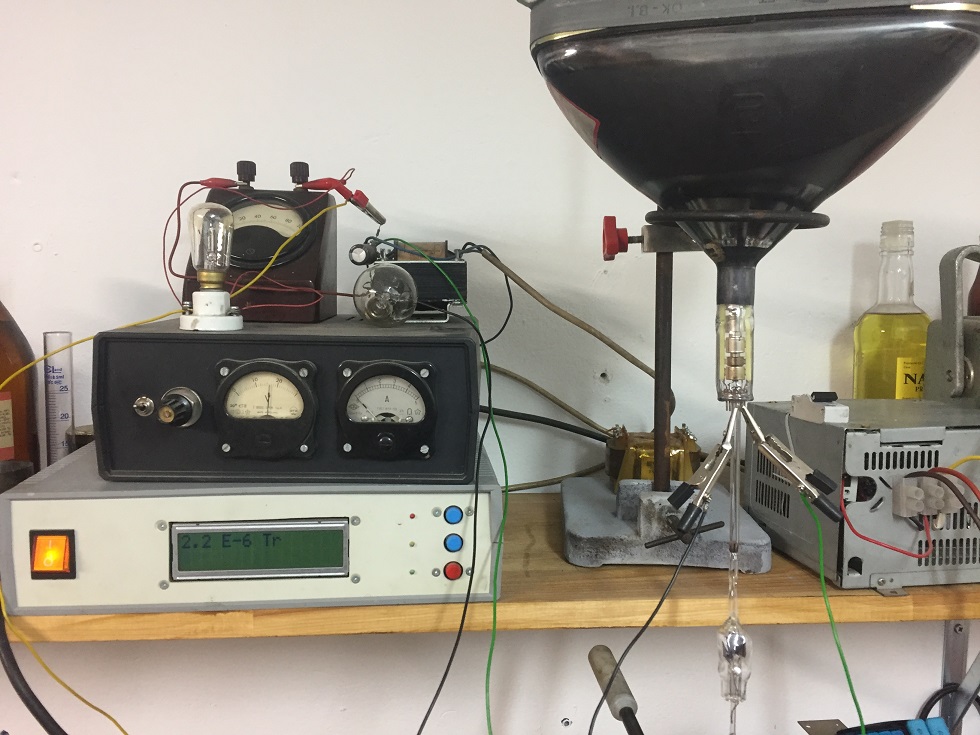 |
Po uformowaniu wstępnym katody i odcięciu od pompy dyfuzyjnej kineskop wraz z pompą jonową został podłączony do zwłok jakiegoś monitora.
Najpierw pracowała sama pompa jonowa, przy wyłączonym monitorze.
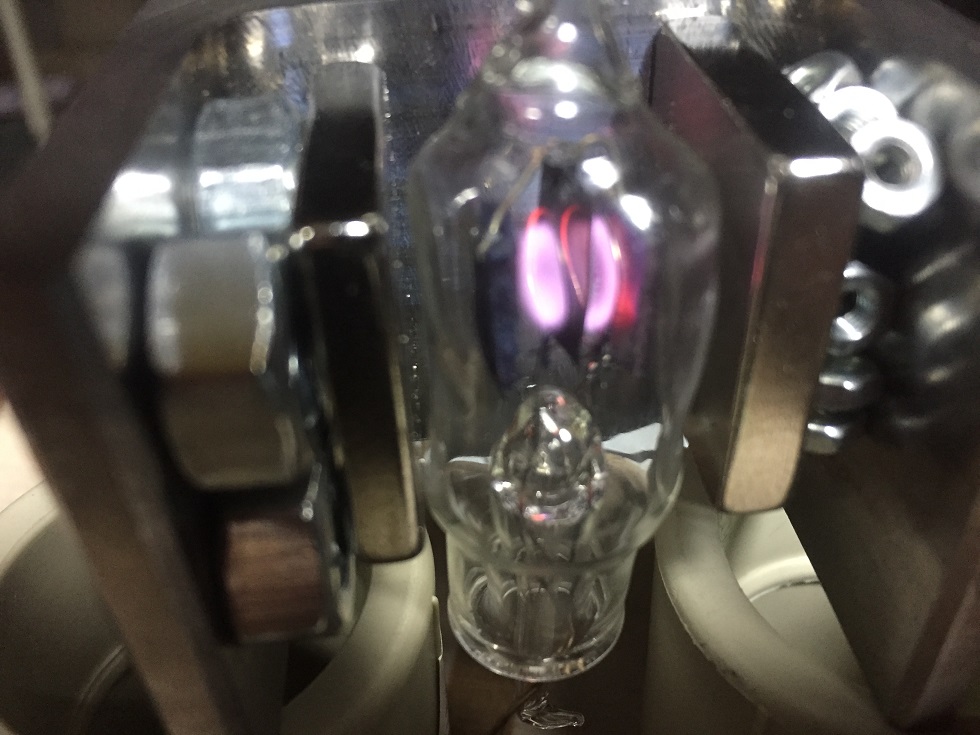 |
Potem zaś, gdy próżnia się poprawiła (zmalał prąd pompy jonowej) można było włączyć monitor. To pozwala na powolne odgazowanie wskutek bombardowania elektronowego.
Wydzielone gazy pompuje pompa jonowa. Nie jest to może najszczęśliwsze rozwiązanie, ale trzeba było improwizować.
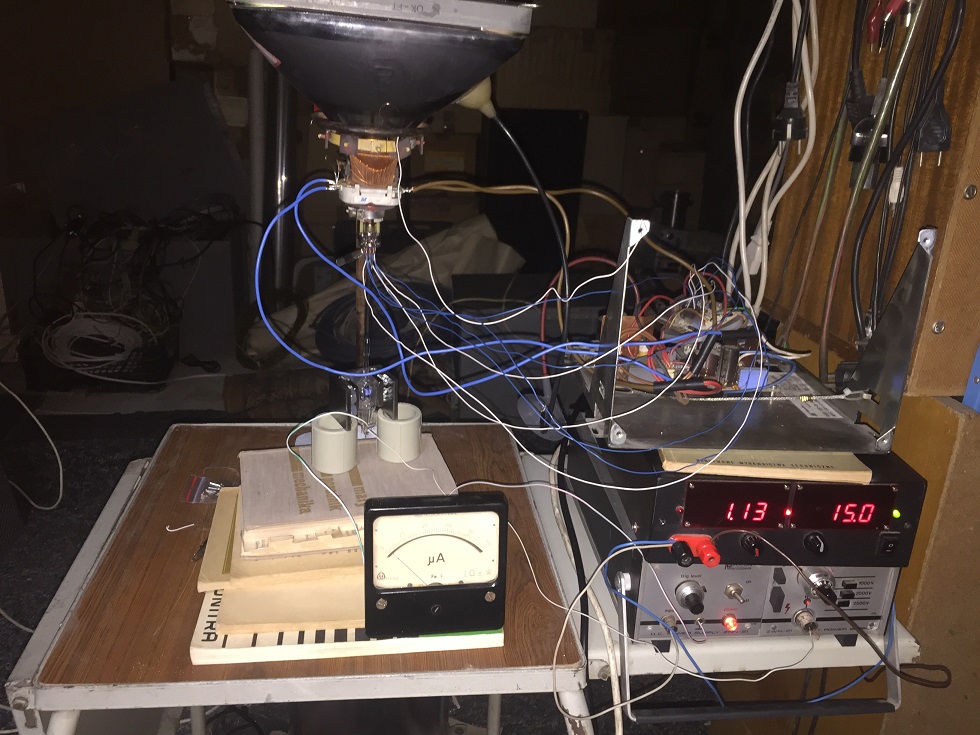 |
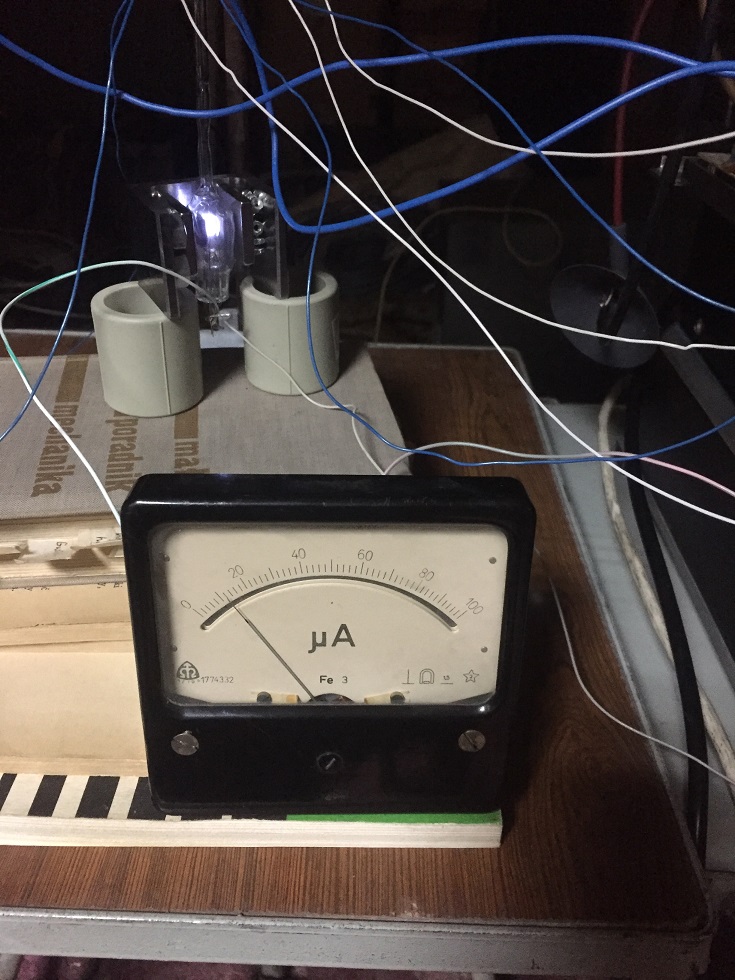 |
Jest to o tyle istotne, że ten kineskop nie był wcześniej dobrze wygrzany.W trakcie tej operacji kineskop stopniowo zaczynał już świecić. Jak się okazało, na zielono.
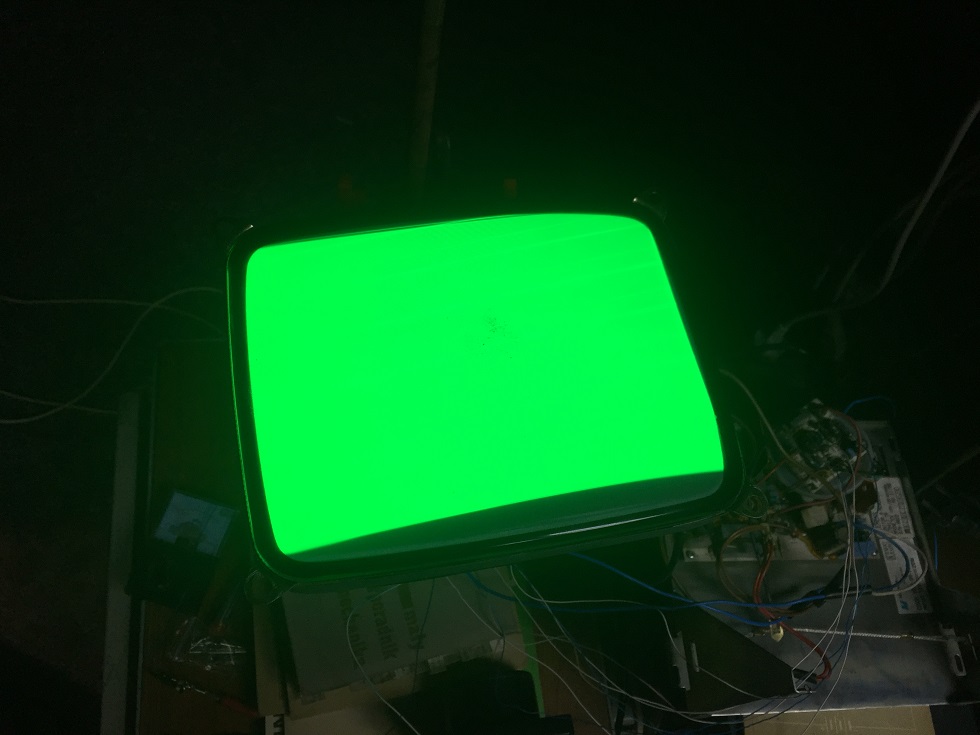 |
Takie wyświecanie kineskopu trwało w tych warunkach około tygodnia.
Na sam koniec pozostało indukcyjne rozpylenie getteru, odtopienie zbędnej już pompy jonowej i nalepienie kartki z datą regeneracji .
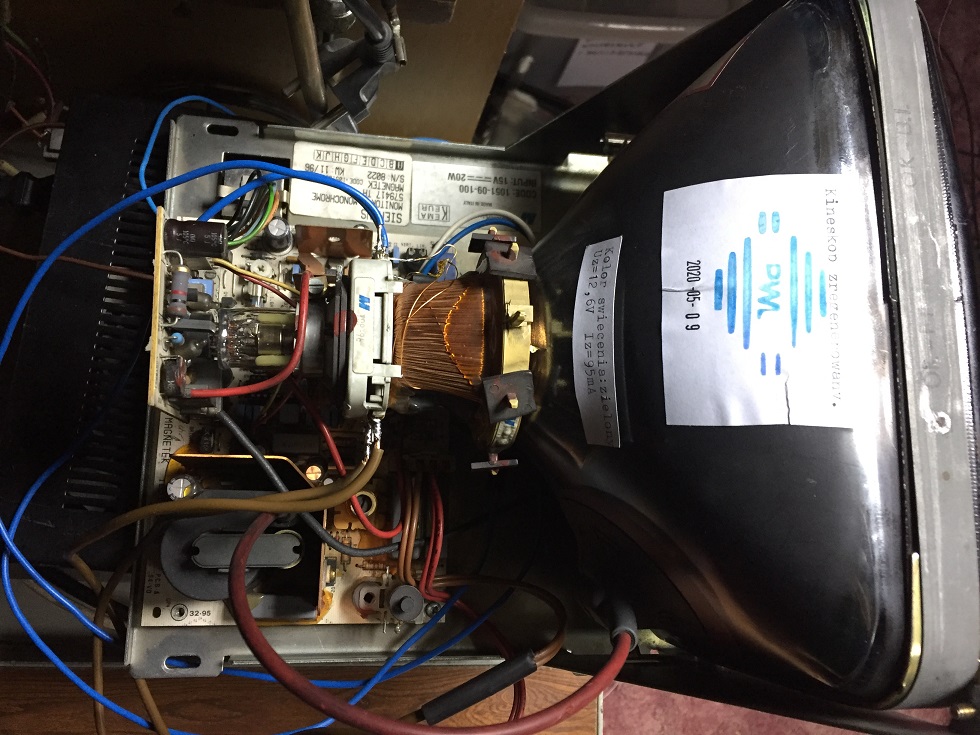 |
Kineskop nie jest może tak "mocny" jak nowy, ale też i procedura odbiegała nieco od normy.
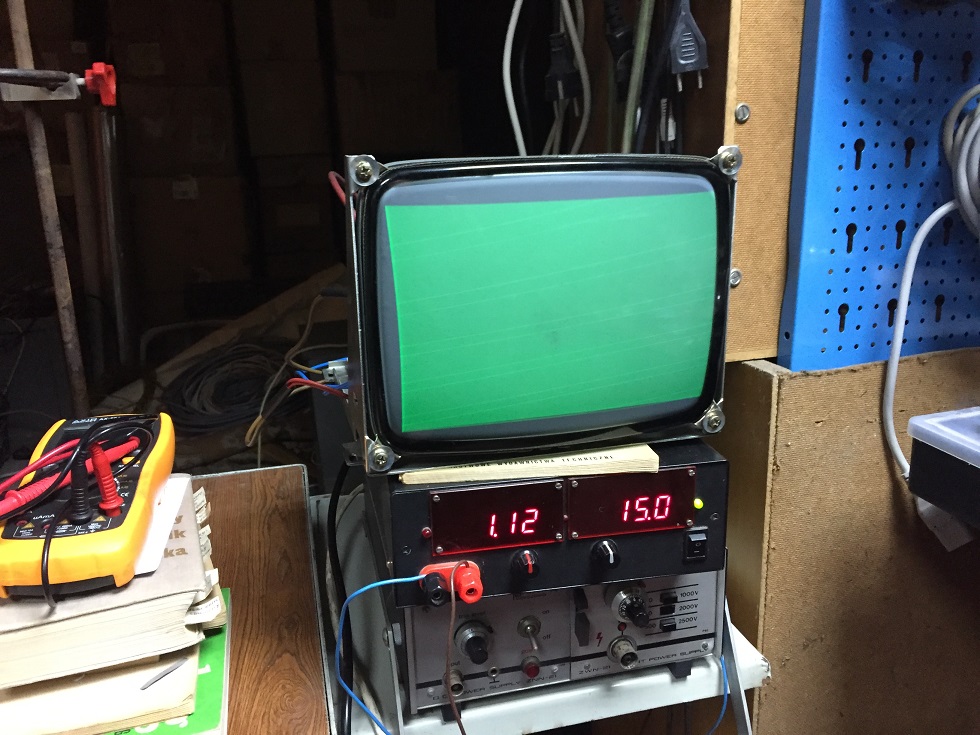 |
Także wtapiana "nowa" wyrzutnia leżała wiele lat, czekając na użycie.
Problemem są właśnie takie materiały. Wyrzutnie są już niedostępne, trudno także o odpowiednie rury szklane na szyjki (20, 29 i 36 mm) ze szkła ołowiowego. Może jeszcze ktoś ma takie komponenty? Jeśli tak, to jestem nimi zainteresowany.
Ten kineskop był naprawiony na próbę. Docelowo myślę o naprawie modeli starszych. Na przeszkodzie stoi jednak brak osprzętu (większej zatapiarki i stanowiska do pompowania z wygrzewaniem). Z zakładu z ul. Płońskiej kupiłem przed 2010 r. jedynie palnik do zatapiania
wyrzutni, ale użyłem go dawno temu jedynie na próbę.
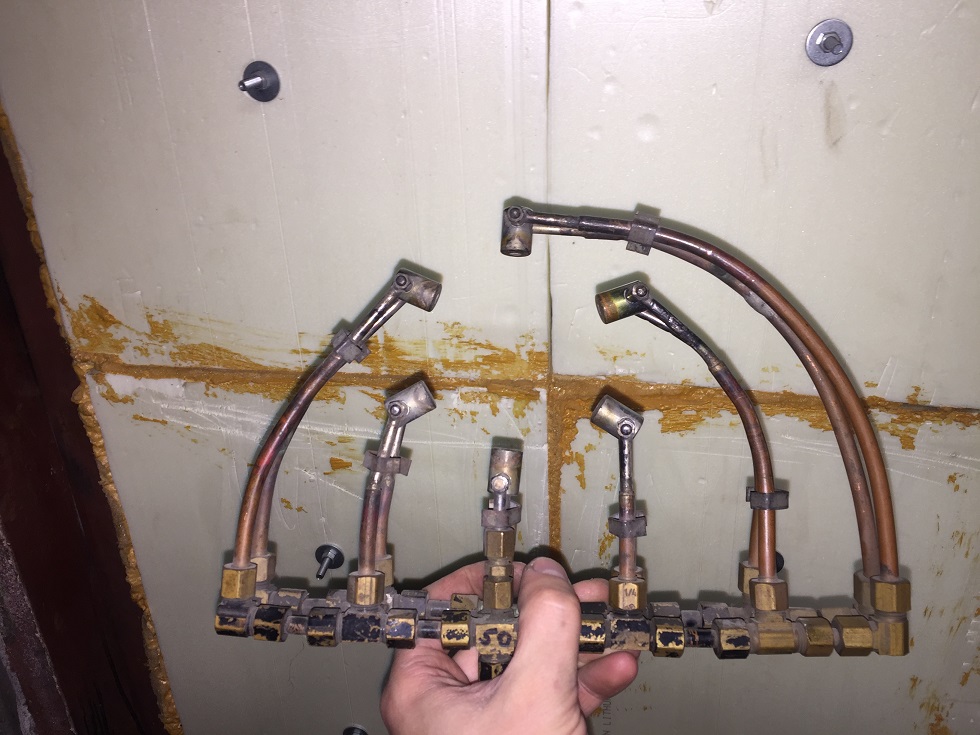 |
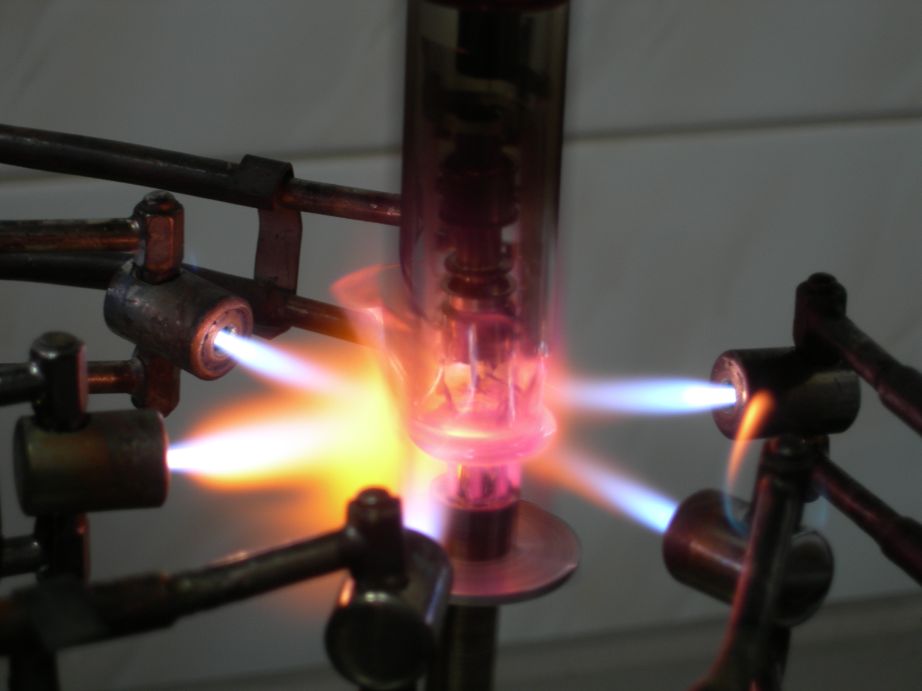 |
Powrót do strony "TV retro"


